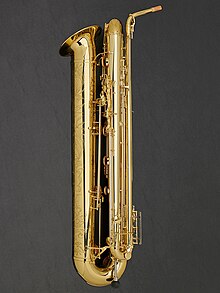Tubax

 | |
| Woodwind instrument | |
|---|---|
| Classification | Single-reed |
| Hornbostel–Sachs classification | 422.212-71 (Single-reed aerophone with keys) |
| Inventor(s) | Benedikt Eppelsheim |
| Developed | First derived in 1999 from the contrabass saxophone |
| Playing range | |
 | |
| Related instruments | |
| Sizes: Orchestral saxophones: Specialty saxophones: | |
| Musicians | |
| Builders | |
| Benedikt Eppelsheim | |
The tubax is a modified contrabass saxophone developed in 1999 by the German instrument maker Benedikt Eppelsheim. Although it has the same fingering as the saxophone, Eppelsheim's design reduces the amount of expansion of its conical bore in relation to the length of tubing, resulting in a smaller volume of resonant air column. This allows for it to use a smaller mouthpiece (baritone or bass, instead of a larger contrabass mouthpiece), and more compactly folded tubing. The tubax exists in E♭ contrabass and B♭ or C subcontrabass sizes. Its name is a combination of the words "tuba" and "sax".[1]
History
[edit]Eppelsheim's first conception of the tubax came in 1992 or 1993, while working at Bavarian instrument maker Münchner Blech. Prior to this time, while working in Franz Traut's workshop in Munich, he had spent much time experimenting with bocals and repairing saxophones, and built two experimental instruments. At Münchner Blech he was able to work on contrabass and bass saxophones, as well as sarrusophones. Noting that there were no contrabass saxophones in modern production, he had the idea to build one in a shape reminiscent of the sarrusophone, or the saxophone bourdon on Adolphe Sax's original patent drawing.[1]
The process from idea to production took about seven years. The initial design took about a week, followed by four weeks of building a prototype. Most of the time was spent calculating the scale length and tone hole positions, based on principles described in Cornelis Johannes Nederveen's Acoustical aspects of woodwind instruments and Arthur H. Benade's Fundamentals of musical acoustics.[1]
The first size of tubax to be developed was the E♭ (contrabass) tubax, introduced at the Musikmesse Frankfurt in 1999 and intended as a more practical alternative to the contrabass saxophone.[2] The larger B♭ (subcontrabass) tubax appeared soon after and is equivalent to the subcontrabass saxophone (which, although envisioned as the saxophone bourdon by Adolphe Sax in his 1846 patent, was only first built in 2010 by Brazilian manufacturer J'Élle Stainer).[3] The subcontrabass tubax is also available in C, but only one model has been manufactured, sold to Thomas Mejer of Switzerland in July 2002.[citation needed]
Construction
[edit]The E♭ and B♭ tubax have the same lengths of tubing as the contrabass and subcontrabass saxophones respectively, but are much more compact.[4] They are built with a narrower conical bore, somewhere between a regular saxophone and a contrabass sarrusophone, and use comparatively smaller baritone or bass saxophone mouthpieces. While saxophones are folded a maximum of three times, rendering saxophones larger than the baritone tall and unwieldy, the tubax is folded four times, to stand only 114 centimetres (3 ft 9 in) high for the E♭ tubax, not much taller than a baritone saxophone, yet an octave lower.[5] Similarly, the B♭ tubax stands 145 centimetres (4 ft 9 in) tall, nearly half of the enormous 2.74-metre (9 ft 0 in) height of an equivalent subcontrabass saxophone.[6][7] Despite this, the tubax retains identical fingering to a standard saxophone, including an altissimo F♯ key. This required completely redesigned keywork, which also brings the hands to a more comfortable position. The smaller size and more accessible key placements result in more portable and ergonomic instruments.[5] The tubax also has a more focused and compact timbre than that of the full-sized saxophones.
Repertoire and performance
[edit]
Given its short history and rarity, little has been specifically written for the tubax, but it can readily be used for any material intended for bass or contrabass saxophone. The tubax, like the saxophone, is a transposing instrument notated in treble clef. The E♭ and B♭ models have identical ranges to the contrabass and subcontrabass saxophones, respectively. Built without the low A key found on some low saxophones, the lowest note of the E♭ tubax is thus D♭1, an octave below the lowest note of the baritone saxophone. The lowest note of the B♭ tubax is A♭0, a semitone below the lowest note on the piano keyboard (A0).
Notable performers:
- Paul Cohen
- Dror Feiler
- Blaise Garza
- Vinny Golia
- Mats Gustafsson
- Uwe Ladwig
- Pat Posey
- Jarno Sarkula
- Steffen Schorn
- Jim Sheppard
- Colin Stetson
- Marcus Weiss
References
[edit]- ^ a b c "Interview mit Benedikt Eppelsheim". Saxophonforum: Die deutschsprachige Saxophoncommunity (in German). 13 February 2008. Retrieved 8 September 2023.
- ^ "Bass saxophones, The Tubax contrabass saxophone and The Soprillo piccolo saxophone made by Benedikt Eppelsheim". www.pro-music-news.com. Retrieved 8 September 2023.
- ^ Berni, Attilio (21 February 2013). "J'Elle Stainer Double Bb Sub-contrabass Saxophone". saxophone.org. Retrieved 22 November 2022.
- ^ Cohen, Paul (September 2000). "Redefining the saxophone, Soprillo and Tubax: new saxophones for a new millennium". Saxophone Journal. 25 (1). Needham, MA: Dorn Publications: 8–10. ISSN 0276-4768.
- ^ a b Kahlke, Helen (11 May 2012). "Eb Tubax". Bassic Sax. Retrieved 22 November 2022.
- ^ "Tubax (B♭)". Munich, Germany: Benedikt Eppelsheim Wind Instruments. Retrieved 6 November 2022.
- ^ "Largest saxophone - playable by one person". Guinness World Records. 3 August 2013. Retrieved 22 November 2022.